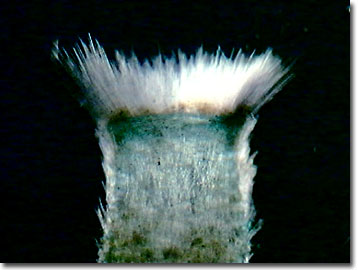Darkfield Digital Image Gallery
Grantia Sponge
Sponges, colonial animals in the phylum Porifera, are primitive invertebrates that are dominated by marine species. Typically, they are benthic, sessile filter feeders that are asymmetrical. Grantia is a genus of calcareous marine sponges that is sometimes referred to as Scypha in older texts. This group of sponges demonstrates the sycon body plan in which the wall of the colony is folded into a series of internal and external canals that circulate water to bring in dissolved oxygen and prey while removing waste products.

Water enters a Grantia sponge through several incurrent canals (ostia) and passes through internal pores or prosopyles that act like flood gates or valves. The incoming water, bearing dissolved oxygen, dissolved solids, and suspended food such as plankton and bacteria, then enters the radial canals that are lined with choanocytes. Choanocytes are flagellated collar cells that keep the water moving throughout the sponge. As the water is moved along by the flagella, suspended food particles are drawn through the collar and then digested through phagocytosis by amebocytes. The amoebocytes carry nutrition to other parts of the sponge colony and compensate for the lack of a circulatory system. From the radial canals, water enters the central opening or spongocoel through apopyles (small pores). The exit or excurrent canal for the sycon type sponges is a single, relatively larger opening that is often referred to as the osculum.
The amebocytes secrete spicules of calcium carbonate in the gelatinous protein matrix of the sponge between the epidermis and the choanocytes. As diploblasts, sponges including Grantia exhibit only two germ layers, the endoderm and ectoderm. There is no mesoderm as with more advanced invertebrate and vertebrate animals. Another primitive characteristic of sponges is the option of sexual or asexual reproduction. Budding and fragmentation allows Grantia sponges to form identical offspring while sexual reproduction permits genetic mixing. Environmental conditions including water temperature, tidal stage, and the phase of the moon need to be near perfect or else sexual reproduction by these sponges is postponed.
Contributing Authors
Cynthia D. Kelly, Thomas J. Fellers and Michael W. Davidson - National High Magnetic Field Laboratory, 1800 East Paul Dirac Dr., The Florida State University, Tallahassee, Florida, 32310.
BACK TO THE DARKFIELD IMAGE GALLERY
BACK TO THE DIGITAL IMAGE GALLERIES
Questions or comments? Send us an email.
© 1995-2025 by Michael W. Davidson and The Florida State University. All Rights Reserved. No images, graphics, software, scripts, or applets may be reproduced or used in any manner without permission from the copyright holders. Use of this website means you agree to all of the Legal Terms and Conditions set forth by the owners.
This website is maintained by our
Graphics & Web Programming Team
in collaboration with Optical Microscopy at the
National High Magnetic Field Laboratory.
Last Modification Friday, Nov 13, 2015 at 01:19 PM
Access Count Since September 17, 2002: 74755
Visit the website of our partner in introductory microscopy education:
|
|
